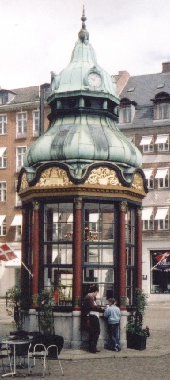| Copenhagen 14th - 16th June 2001 Researched and led by Sue Hayton |
|
| On the Friday morning two bus rides took us to Knippelsbro Bridge whence it was a short walk to the Burmeister & Wain Museum. B&W, founded in 1843, were shipbuilders and engineers, later specialising in large diesel engines for ships, a business which continues under the ownership of MAN. The company museum contains many interesting models of ships and diesel engines some of which can be set in motion at the touch of a button. Not much of the old buildings now remain but the 18th-century church, Christians Kirke, built for workers from Germany and rather designed like an opera house, was interesting. Inside is a memorial to Peter Appelby, an English shipbuilder who worked in Copenhagen in the 18th century.
From the museum we had a walk in the Christianshavn area, the 17th-century harbour developed by King Christian IV. The main interest is the 18th- and 19th-century warehouses but there are also the former naval hospital of 1755 which is now the Royal Danish Naval Museum (Orlogsmuseet) and the offices of the Asiatisk Kompagni. This brought us to the Nyhavn which is lined with merchants’ houses only one of which is original, dating from 1681. Most of the houses are now restaurants and this was our lunch stop.
After lunch we explored the Nyhavn and more warehouses, the Royal Silk Manufactory, passed the modern ferry terminal and across the water saw the Royal Dockyards, which have a number of old and interesting buildings but are not open to the public. Through the Amalienborg, the square in which the royal palace is situated, we went to a group of houses, the Nyboder built from 1631 for members of the services. Some originals remain in Sankt Poulsgade but many have been altered. Further walking took us past the offices of the state railways, which was originally a barracks, the Kommunhospital, built in the 1860s with the most modern facilities as publicised by Florence Nightingale, and the Kartoffelrækkerne, 11 small streets of workers' housing nicknamed 'Potato Rows'. From the Westerport Station we returned to the Central Station and the hotel. |
|
|
Saturday morning was devoted to the old city centre, including Vandverks Pumpestation, the first city waterworks, the Circusbygning, claimed to be the oldest purpose-built circus building in the world, the Bryggehus, the brewery which supplied the navy, the Tøjhusmuseet, the old arsenal, the Børsen, the Exchange, a Dutch design and finishing at the Hovedbanegården, the Central Station and lunch. The first station was built in 1847, the present station dates from 1904-1911. The impressive passenger hall is roofed with twin timber-trussed arches on brick walls.
Saturday afternoon was devoted to brewing. First call was the Carlsberg Brewery. The earliest buildings date from 1847 and are now the offices of the Carlsberg Foundation. There is also workers housing which we rather hurried past because the closure of a pedestrian bridge meant we had a longer walk than expected. The monumental buildings of 1892 remain, including the impressive gateway with a 1901 watertower supported by four granite elephants. We spent some time in the brewery museum including the stables for the dray horses and two free glasses of beer. From Carlsberg there was a long bus ride across the city to the Tuborg site. This is a complete contrast since almost all the site has been redeveloped. The headquarters building remains and another office block is evidently being retained. There is also the largest beer bottle in the world, a concrete replica designed for publicity purposes. |
|
|
Sunday morning was devoted to commercial Copenhagen. Starting at the Rådhus, City Hall, we walked the 1.8km of the pedestrianised street known as the Strøget with many interesting shops and offices.
Off Strøget is the brewers' quarter with the birth place of JC Jacobsen, the founder of Carlsberg, the 17th-century Rundetårn with an internal ramp so that the king's sedan chair could be carried up to the top, which was also an observatory, the Kongelige Porcelænsfabrik, the famous Royal Copenhagen Porcelain works, WO Larsens Pipe Museum in an old tobacconists shop and the Magasin du Nord, a department store in a Parisian style. Right: An historic telephone kiosk on Kongens Nytorv |
 |
| After lunch we assembled at the station for the trip over the new Øresund Bridge, a joint venture between the Danish and Swedish authorities to cross the Sound from Copenhagen to Malmö. The first part of the £4.5 billion, 16km project is a tunnel from an artificial peninsular near the airport to an artificial island. The tunnel has four tubes, two for cars, two for trains. Then there is a 3km approach of 18 140m and four 120m spans with the road above the railway. The 'High Bridge' comes next. This is a central cable-stayed span 1km long, supported on four pylon legs and suspended from 80 pairs of cables. Finally there is the approach bridge on the Swedish side comprising 24 140m and four 120m spans. The crossing from central Copenhagen to Central Malmö takes about 30 minutes. | |
| The afternoon was spent in Malmö which is an old and interesting city. The sites included the station, obviously since we had arrived there, the Rädhus, City Hall, the Flensburgska Huset of 1590, the Lilla Torg or Little Square surrounded by old buildings, the Apoteket Lejonet, the oldest pharmacy in Malmö and the Elektricitetswerket, an impressive brick and stone building of 1901 which is now an arts complex. We returned to Copenhagen by the bridge and dispersed. It had been a full but fascinating three days. | |
| Words by Bill Firth, from the GLIAS Newsletter No 195, August 2001 | |
| All images Copyright © Dan Hayton 2001 | |
